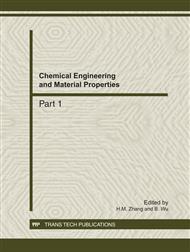p.497
p.501
p.505
p.511
p.517
p.524
p.530
p.535
p.540
Conductive and Mechanical Properties of Graphite Nanoplatelets/PVC Nanocomposites Prepared by Melt Blending
Abstract:
Graphite nanoplatelets (Nano-Gs) were prepared by treating the expanded graphite with sonication in aqueous alcohol solution, and then the Nano-Gs/ PVC nanocomposites were fabricated by way of melt blending. The structure of Nano-Gs was characterized by FTIR and SEM, the conductive and mechanical properties of the Nano-Gs/ PVC nanocomposites were also studied. Results show that with a small amount of functional groups distributing on the surface, Nano-Gs have a thickness ranging 30-100nm and a diameter ranging 3-20μm, and disperse randomly in PVC resin matrix. The Nano-Gs/ PVC nanocomposites exhibit low volume resistivity of 104Ω•cm when the mass fraction of Nano-Gs goes beyond 10%, and the percolation threshold of the nanocomposites is as low as 6wt%. Furthermore, with the increase of the filled Nano-Gs, both the tensile strength and notched impact strength of the nanocomposites increase first and then decrease, and achieve the maximal value simultaneously with the addition of 1 wt% Nano-Gs, which increase by 8% and 29% respectively compared with the pristine PVC.
Info:
Periodical:
Pages:
517-523
Citation:
Online since:
December 2011
Authors:
Price:
Сopyright:
© 2012 Trans Tech Publications Ltd. All Rights Reserved
Share:
Citation:


